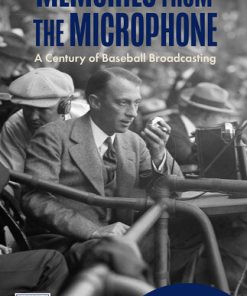Teaching Statistics Using Baseball 2nd Edition by Jim Albert ISBN 1614446229 9781614446224
$50.00 Original price was: $50.00.$25.00Current price is: $25.00.
Teaching Statistics Using Baseball 2nd Edition by Jim Albert – Ebook PDF Instant Download/Delivery: 1614446229, 9781614446224
Full download Teaching Statistics Using Baseball 2nd Edition after payment
Product details:
ISBN 10: 1614446229
ISBN 13: 9781614446224
Author: Jim Albert
Teaching Statistics Using Baseball 2nd Edition: Teaching Statistics Using Baseball is a collection of case studies and exercises applying statistical and probabilistic thinking to the game of baseball. Baseball is the most statistical of all sports since players are identified and evaluated by their corresponding hitting and pitching statistics. There is an active effort by people in the baseball community to learn more about baseball performance and strategy by the use of statistics. This book illustrates basic methods of data analysis and probability models by means of baseball statistics collected on players and teams. Students often have difficulty learning statistics ideas since they are explained using examples that are foreign to the students. The idea of the book is to describe statistical thinking in a context (that is, baseball) that will be familiar and interesting to students. The book is organized using a same structure as most introductory statistics texts. There are chapters on the analysis on a single batch of data, followed with chapters on comparing batches of data and relationships. There are chapters on probability models and on statistical inference. The book can be used as the framework for a one-semester introductory statistics class focused on baseball or sports. This type of class has been taught at Bowling Green State University. It may be very suitable for a statistics class for students with sports-related majors, such as sports management or sports medicine. Alternately, the book can be used as a resource for instructors who wish to infuse their present course in probability or statistics with applications from baseball. The second edition of Teaching Statistics follows the same structure as the first edition, where the case studies and exercises have been replaced by modern players and teams, and the new types of baseball data from the PitchFX system and fangraphs.com are incorporated into the text.
Teaching Statistics Using Baseball 2nd Edition Table of contents:
Chapter 1: An Introduction to Baseball Statistics
Chapter 2: Exploring a Single Batch of Baseball Data
- 2.1 Looking at Teams’ Offensive Statistics
- 2.2 A Tribute to Derek Jeter
- 2.3 A Tribute to Randy Johnson
- 2.4 Analyzing Baseball Attendance
- 2.5 Manager Statistics: The Use of Sacrifice Bunts
- 2.6 Exercises
Chapter 3: Comparing Batches and Standardization
- 3.1 Albert Pujols and Manny Ramirez
- 3.2 Robin Roberts and Whitey Ford
- 3.3 Home Runs: A Comparison of Four Seasons
- 3.4 Slugging Percentages are Normal
- 3.5 Great Batting Averages
- 3.6 Exercises
Chapter 4: Relationships Between Measurement Variables
- 4.1 Relationships in Team Offensive Statistics
- 4.2 Runs and Offensive Statistics
- 4.3 Most Valuable Hitting Statistics
- 4.4 A New Measure of Offensive Performance
- 4.5 How Important is a Run?
- 4.6 Baseball Players Regress to the Mean
- 4.7 Exercises
Chapter 5: Introduction to Probability Using Tabletop Games
- 5.1 What is Chris Davis’ Home Run Probability?
- 5.2 Big League Baseball
- 5.3 All-Star Baseball
- 5.4 Strat-O-Matic Baseball
- 5.5 Exercises
Chapter 6: Probability Distributions and Baseball
- 6.1 The Binomial Distribution and Hits per Game
- 6.2 Modeling Runs Scored: Getting on Base
- 6.3 Modeling Runs Scored: Advancing the Runners to Home
- 6.4 Exercises
Chapter 7: Introduction to Statistical Inference
- 7.1 Ability and Performance
- 7.2 Simulating a Batter’s Performance if His Ability is Known
- 7.3 Learning About a Batter’s Ability
- 7.4 Interval Estimates for Ability
- 7.5 Comparing Wade Boggs and Tony Gwynn
- 7.6 Exercises
Chapter 8: Topics in Statistical Inference
- 8.1 Situational Hitting Statistics for Mike Trout
- 8.2 Observed Situational Effects for Many Players
- 8.3 Modeling On-Base Percentages for Many Players
- 8.4 Models for Situational Effects
- 8.5 Is Michael Brantley Streaky?
- 8.6 A Streaky Die
- 8.7 Exercises
Chapter 9: Modeling Baseball Using a Markov Chain
- 9.1 Introduction to a Markov Chain
- 9.2 A Half-inning of Baseball as a Markov Chain
- 9.3 Useful Markov Chain Calculations
- 9.4 The Value of Different On-base Events
- 9.5 Answering Questions About Baseball Strategy
- 9.6 Exercises
People also search for Teaching Statistics Using Baseball 2nd Edition:
how are baseball stats calculated
learning baseball stats
how to figure out baseball stats
teaching how to hit a baseball
how to take baseball stats
Tags:
Jim Albert,Teaching,Statistics,Baseball
You may also like…
Mathematics - Mathematical Statistics
Statistics using R an integrative approach 2nd Edition Sharon L. Weinberg
Education Studies & Teaching
Uncategorized
Education Studies & Teaching - School Education & Teaching
Using Educational Psychology in Teaching 11th Edition Paul Eggen
Uncategorized












